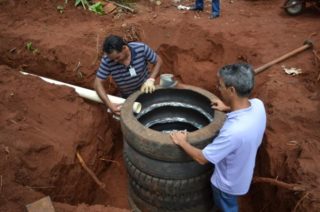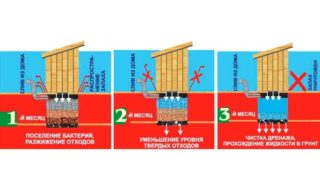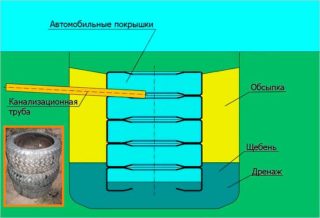A cesspool is a sewerage facility where drains and sewage are discharged. This is the easiest and cheapest way to organize an autonomous sewage system at a summer cottage. Different materials are used for the construction of the pit. One interesting option is car tires. They are rubber, sewage drains do not affect them in any way, so the tires will serve for many years. But before you make a cesspool from car tires with your own hands, you need to find a place for a sewer system, and also understand the principle of its operation.
The device and principle of operation of the drain pit
Environmental standards required sewerage structures to be sealed, and wells in which sewage was filtered through the ground, equipped with natural filtration layers. Therefore, at the bottom of the cesspools, coarse sand or crushed stone of a medium or large fraction began to fall asleep.
Wastewater enters the constructed reservoir, part of the solid particles is processed by bacteria, part settles on the bottom and walls, and water goes through the bottom into the ground. At the same time, it becomes clarified, that is, it practically does not harm the environment.
Sewer drains enter the drain pit through a pipe that is led at an angle from the house.
Calculation and design
- the number of people permanently living in the house;
- the amount of water consumed by one person per day - this value is standard, and it is equal to 200 liters or 0.2 m³;
- the time it takes for bacteria to process organic matter in sewage, this value is also standard - 3 days.
Calculation example:
3x0.2x3 = 1.8 m³ - this is the volume of a cesspool for a house in which 3 people live.
There are standard standards for the remoteness of a hydraulic structure from facilities located at a summer cottage:
- from the foundation of the main house - 5 m;
- from a well or a well - 50 m;
- from open natural or artificial reservoirs - 30 m;
- from vegetation - 3 m.
Attention! Solids collecting at the bottom of the tank cover the filter bed, making it difficult for the clarified water to penetrate into the ground. Therefore, the cesspool must be cleaned periodically. It is better to do this with a sewer truck. Therefore, it is necessary to build a sump not far from the fence erected by the road.
Stages of construction of a cesspool

To make a sewage system from Kamaz car wheels, you first need to dig a hole with a diameter slightly larger than the diameter of the tires. In this case, it is necessary to take into account the required volume of the future structure. Therefore, you must first measure the inner diameter of the wheel, find its area by the formula: S = πD² / 4 = 3.14xD² / 4.
The resulting value is multiplied by the tire width. This will be the approximate inner volume of the wheel. After that, the calculated volume of the pit is divided by this parameter. The end result is the number of tires required. Accordingly, the depth of the pit will be equal to the width of the wheels multiplied by the received amount.
Since the bottom of the structure will need to be covered with a filtering layer, the depth is increased by 30-50 cm.
The next stage is earthworks. Dig a hole for the tires, a trench for a sewer pipe. The best option for the latter is a straight section from the house to the pit. The pipe is laid at a slope of 2-3 °.
Construction of a cesspool
At the bottom of the pit, a garden drill should be drilled a hole 1-2 m deep. A plastic pipe 2-3 m long, 100-200 mm in diameter is inserted into it, in which holes 5-10 mm in diameter are drilled. The latter are drilled evenly along that part of the pipe that is located half a meter above the bottom of the pit. The open upper edge of the pipe must be closed with a synthetic fine mesh. This is a drainage system for draining clarified water into the ground.
- The bottom of the pit is covered with rubble or sand.
- The filtering layer is leveled.
- Two tires are laid on it, one on top of the other.
- They are aligned with each other.
- Cross holes are made in the mating surfaces.
- Galvanized wire is passed through them (you can use plastic clamps) and twist it. In this way, two car tires are fastened together.
- Further, the rest of the wheels are stacked on top, fastened together.
The main task of the contractor is to achieve the tightness of the structure being erected. Therefore, on the outside, the tire joints are covered with a cement-sand mixture or bitumen mastic. This should be done immediately in the process of laying each wheel.
As soon as all the tires are laid, the sinuses are backfilled between the walls of the pit and the tires. For this, the soil selected from the pit is used. But it is better to mix it with sand.
The last car tire to be placed must be above the ground.
The outer sidewalls of the upper tire are sprinkled with soil, which is tamped. This is a blind area that will protect the sewer sump from precipitation and melting snow. Above it is necessary to lay an insulated hatch. This can be a wooden cover made from planks. Its inner surface must be pasted over with foam. A hole is made in the hatch, where a ventilation pipe is inserted to remove unpleasant odors. The longer the pipe, the better.
Maintenance of cesspools

For the sump to work efficiently, it must be pumped out periodically. Therefore, at least once a month it is necessary to open the hatch and inspect - whether the hole is full to the brim. If necessary, pump it out.
For a more effective purification of sewage, it is recommended to introduce biological preparations - dry bacteria - into the cesspool. The latter, upon contact with water, come to life and begin to process organic matter.
If necessary, chemicals are poured into the sump. They completely break down the contents of the sewer system, disinfect and remove the unpleasant odor. But in doing so, the chemicals kill all bacteria. After chemical cleaning, dry bacteria must be filled in.
Advantages and disadvantages
The main advantage of a sump made of tires is ease of construction and a small construction budget. Service life - up to 15 years.
The biggest drawback is poor performance. In winter, the system often freezes up. An unpleasant smell with a low tightness of the structure quickly spreads over the summer cottage. The degree of purification is up to 40%, which is considered insufficient for modern sewage systems. Therefore, there is a possibility that sewage will fall into the ground.










